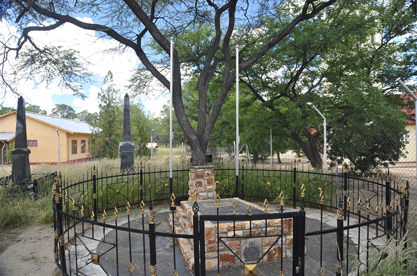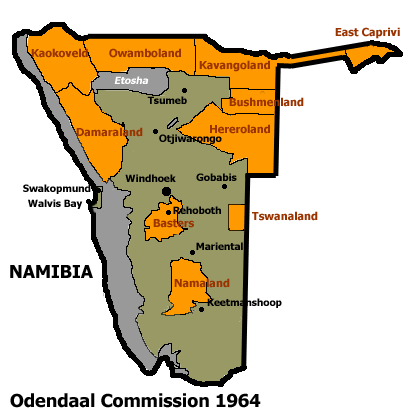|
Hoachanas
Hoachanas (Khoekhoe language, Khoekhoe: ) is a List of villages and settlements in Namibia, settlement of 3,000 inhabitants in the Hardap Region of southern central Namibia, located northeast of Kalkrand. It is situated at the junction of the main road C21 from Kalkrand, and C15 from Dordabis to Stampriet and belongs to the Mariental Rural electoral constituency. Inhabited since at least 1695, Hoachanas is the main settlement of the Khaiǁkhaun (Red Nation, Namibia, Red Nation), the largest and most important of the subtribes of the Nama people. All tribal chief, chiefs of the Red Nation had their main residence at this settlement. Hoachanas is also the home of Markus Kooper, reverend, educator and anti-apartheid activist. Hoachanas has a Combined School from Pre- Primary to Grade 11 that is named after the first principal of the school Piet Jan Tsai-Tsaib. Geography Hoachanas is situated on Namibia's Central Plateau in an Acacia tree and shrub savanna typical for the Kalahari ... [...More Info...] [...Related Items...] OR: [Wikipedia] [Google] [Baidu] |
Markus Kooper
Reverend Markus Kooper (12 September 1918 – 9 December 2005) was a Namibian activist, educator and religious figure. From Hoachanas in the Hardap Region, Kooper was one of the first Namibians who travelled to the United Nations to petition for his country's independence from apartheid South Africa. He is buried at the National Heroes Acre memorial cemetery outside of Windhoek. Kooper studied with the Rhenish Missionary Society and received teacher training in Okahandja from 1939 to 1942. He then taught at missionary schools in Stampriet, Gochas and Hoachanas until 1946 and became headmaster at Hoachanas in 1949. He also attended ministry training with the African Methodist Episcopal Church and was ordained as deacon. Kooper became the spiritual leader of his community and was appointed to Hoachanas' Pastoral Church in 1955. In 1956, Kooper spoke before the United Nations on the issue of South West Africa along with Reverend Michael Scott, Mburumba Kerina, Hans Beukes, Fanu ... [...More Info...] [...Related Items...] OR: [Wikipedia] [Google] [Baidu] |
Red Nation, Namibia
The Red Nation () is the main subtribe of the Nama people in Namibia and the oldest Nama group speaking Khoekhoegowab, the language often called Damara/Nama. The main settlement of the Red Nation is Hoachanas, a small settlement in southern central Namibia, today part of the Hardap Region. History Pre–colonial period The word ''Khaiǁkhaun'' means "great defender" in Khoekhoe, from ǁkhau, "defend". There is no agreement as to where the name ''Red Nation'' originated from. Heinrich Vedder claims that the Khaiǁkhaun called themselves ǀAwa-khoi, "red people", whereas Klaus Dierks declares that the Europeans later nicknamed the tribe ''Red Nation''. In any case, the attribution is a reference to their slightly reddish face color. The first Kaptein of the Khaiǁkhaun was ǂHâb who unified most of the Nama clans at the end of the 17th century. After ǂHâb's death in 1710 the ǁKhauǀgoan (Swartbooi Nama) and the ǂKharoǃoan (Keetmanshoop Nama) were the first Nama groups to ... [...More Info...] [...Related Items...] OR: [Wikipedia] [Google] [Baidu] |
Nama People
Nama (in older sources also called Namaqua) are an African ethnic group of South Africa, Namibia and Botswana. They traditionally speak the Khoekhoe language, Nama language of the Khoe languages, Khoe-Kwadi language family, although many Nama also speak Afrikaans. The Nama People (or Nama-Khoe people) are the largest group of the Khoekhoe people, many of whom have disappeared as a group. Many of the Nama clans live in Central Namibia and the other smaller groups live in Namaqualand, which today straddles the Namibian border with South Africa. History The Khoisan peoples of South Africa and southern Namibia maintained a nomadic life since time immemorial. The Khoekhoe were pastoralists and the San people lived as hunter-gatherers. The Nama are a Khoekhoe group. They originally inhabited the Orange River in southern Namibia and northern South Africa. The early colonialists referred to them as ''Hottentots''. Their alternative historical name, "Namaqua", stems from the addition o ... [...More Info...] [...Related Items...] OR: [Wikipedia] [Google] [Baidu] |
List Of Villages And Settlements In Namibia
Villages and settlements in Namibia are distinguished by the status the Government of Namibia has vested in them: Places in Namibia that are governed by a village council are ''villages'', they are the smallest entities of local government. All other places except cities and towns are not self-governed, they are called ''settlements''. Villages Namibia has 18 villages, each of them governed by a village council of up to five seats. Village councils are elected locally and have the authority to set up facilities like water, sewerage and cemeteries without the approval of the Minister of Urban and Rural Development. They may also declare streets and public places, collect fees for the services they provide, and buy immovable property without asking for explicit approval. The eighteen villages are: Settlements Settlements in Namibia are non self-governed populated places. While they may have a dedicated person responsible for their administration, this person is not elect ... [...More Info...] [...Related Items...] OR: [Wikipedia] [Google] [Baidu] |
Jonker Afrikaner
Jonker Afrikaner (3 February 1785, 18 August 1861, Okahandja) was the fourth Captain of the Orlam in South West Africa, succeeding his father, Jager Afrikaner, in 1823. Soon after becoming ''Kaptein'', he left his father's settlement at Blydeverwacht with three brothers and some 300 followers and relocated to the area that is today central Namibia. From 1825 onwards he and his council played a dominant political role in Damaraland and Namaland, creating a '' de facto'' state. Around 1840, he established a settlement at Windhoek where he built a church for a congregation of between 500 and 600 in the area of the present-day Klein Windhoek suburb. He is further known for his road-building activities in central and southern Namibia, particularly the one over the Auas Mountains to the south and the northern Bay Road from Windhoek to Walvis Bay Walvis Bay (; ; ) is a city in Namibia and the name of the bay on which it lies. It is the List of cities in Namibia, second lar ... [...More Info...] [...Related Items...] OR: [Wikipedia] [Google] [Baidu] |
Kalahari
The Kalahari Desert is a large semiarid sandy savanna in Southern Africa covering including much of Botswana as well as parts of Namibia and South Africa. It is not to be confused with the Angolan, Namibian, and South African Namib coastal desert, whose name is of Khoekhoegowab origin and means "vast place". Etymology ''Kalahari'' is derived from the Tswana word ''Kgala'', meaning "the great thirst", or ''Kgalagadi'', meaning "a waterless place"; the Kalahari has vast areas covered by red sand without any permanent surface water. History The Kalahari Desert was not always a dry desert. The fossil flora and fauna from Gcwihaba Cave in Botswana indicates that the region was much wetter and cooler at least from 30 to 11 thousand Before Present, especially after 17,500 BP. Geography Drainage of the desert is by dry black valleys, seasonally inundated pans, and the large salt pans of the Makgadikgadi Pan in Botswana and Etosha Pan in Namibia. The only permanent rive ... [...More Info...] [...Related Items...] OR: [Wikipedia] [Google] [Baidu] |
Auob River
The Auob River is a river in the Northern Cape province of South Africa and the Hardap Region of Namibia. It flows through the Kgalagadi Transfrontier Park. It is a tributary of the Nossob River. Route The river flows about southeastward through Namibia and Northern Cape. Headwaters * in Namibia Mouth * , Nossob River References Rivers of Namibia Rivers of the Northern Cape {{namibia-river-stub ... [...More Info...] [...Related Items...] OR: [Wikipedia] [Google] [Baidu] |
Orlam
The Oorlam or Orlam people (also known as Orlaam, Oorlammers, Oerlams, or Orlamse Hottentots) are a subtribe of the Nama people, largely assimilated after their migration from the Cape Colony (today, part of South Africa) to Namaqualand and Damaraland (now in Namibia). Oorlam clans were originally formed from Mixed race, mixed-race descendants of indigenous peoples, indigenous Khoikhoi, Europeans and slaves from Mozambique, Madagascar, India and Indonesia. Similar to the other Afrikaans-speaking group at the time, the Trekboers, Oorlam originally populated the frontiers of the infant Cape Colony, later living as semi-nomadic Boer Commando, commandos of mounted gunmen. Also, like the Boers, they migrated inland from the Cape, and established several states in what are now South Africa and Namibia. The Oorlam migration in South Africa also produced the related Griqua people. History Beginning in the late 18th century, Oorlam communities migrated from the Cape Colony north to Na ... [...More Info...] [...Related Items...] OR: [Wikipedia] [Google] [Baidu] |
South-West Africa
South West Africa was a territory under South African administration from 1915 to 1990. Renamed ''Namibia'' by the United Nations in 1968, it became independent under this name on 21 March 1990. South West Africa bordered Angola ( a Portuguese colony before 1975), Botswana ( Bechuanaland before 1966), South Africa, and Zambia (Northern Rhodesia before 1964). During its administration, South Africa applied its own apartheid system in the territory of South West Africa. A German colony known as German South West Africa from 1884 to 1915, it was made a League of Nations mandate of the Union of South Africa following Germany's defeat in the First World War. Although the mandate was repealed by the United Nations on 27 October 1966, South African control over the territory continued. The territory was administered directly by the South African government from 1915 to 1978, when the Turnhalle Constitutional Conference laid the groundwork for semi-autonomous rule. During an in ... [...More Info...] [...Related Items...] OR: [Wikipedia] [Google] [Baidu] |
Acacia
''Acacia'', commonly known as wattles or acacias, is a genus of about of shrubs and trees in the subfamily Mimosoideae of the pea family Fabaceae. Initially, it comprised a group of plant species native to Africa, South America, and Australasia, but is now reserved for species mainly from Australia, with others from New Guinea, Southeast Asia, and the Indian Ocean. The genus name is Neo-Latin, borrowed from Koine Greek (), a term used in antiquity to describe a preparation extracted from '' Vachellia nilotica'', the original type species. Several species of ''Acacia'' have been introduced to various parts of the world, and two million hectares of commercial plantations have been established. Description Plants in the genus ''Acacia'' are shrubs or trees with bipinnate leaves, the mature leaves sometimes reduced to phyllodes or rarely absent. There are 2 small stipules at the base of the leaf, but sometimes fall off as the leaf matures. The flowers are borne in spik ... [...More Info...] [...Related Items...] OR: [Wikipedia] [Google] [Baidu] |
Namaland
Namaland was a Bantustan and then later a non-geographic ethnic-based second-tier authority, the Representative Authority of the Namas, the in South West Africa (present-day Namibia), intended by the apartheid government to be a self-governing homeland for the Nama people. Namaland comprised an area of and was to accommodate the estimated 34,806 southern Namas of the South West African territory. The term Namaland also covers a much broader region of southern Namibia which is the traditional home of the northern Nama people. Their language, Nama, is the only surviving dialect of the Khoekhoe language. The suffix ''-qua'' means “people” and can be added to the names of most Khoekhoe groups. The region of the Northern Cape south of the Orange River is called Namaqualand. Background In the 1960s South Africa, which was administering South West Africa under a League of Nations mandate, came under increased international pressure regarding its minority White rule over the ... [...More Info...] [...Related Items...] OR: [Wikipedia] [Google] [Baidu] |







